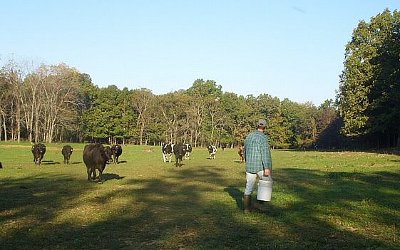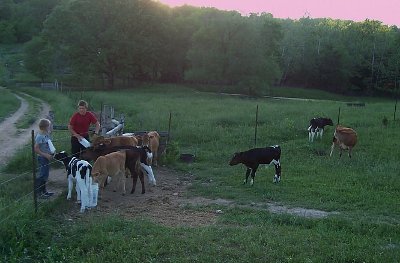
For a couple of years, this recipe was my closely guarded secret, since I sold them, but now, it's more about the health of others rather than money, as it well should be. I have other, more exotic recipes, including shampoo bars, that I can post later if anyone is interested. It just takes a while to type them up. Most of the recipes are out of the book mentioned at the end, a very good investment if you are really interested in making your own soap.
This is a basic recipe. If you have extremely oily skin, Grapeseed or Sunflower Oil are good substitutes for the Olive Oil in the recipe. Other good, but more expensive, Olive oil replacements include Sweet Almond Oil, Aloe Vera Oil, Apricot Kernel Oil, and Flax Seed Oil. They are all relatively close on the saponification chart and will have the same result in bar soaps.
This is also a good recipe to make in bulk, without added fragrance, to have some melt-and-pour base for making more exotic soaps with butters, natural colors from herbs, and scents later. :-)
It works best to either make or purchase a wooden soap frame. A good sized, shallow cardboard box can work too. You will need stainless steel pots, preferably able to be set as a double boiler, a grams-pounds scale, a large glass bowl, sodium hydroxide (lye), your oils, of course, and candy thermometers (or soap thermometers, whichever you prefer). Also, essential oils if you wish to use them for a natural fragrance or for their benefits. The best price I have found on lye is at http://www.essentialdepot.com/servlet/the-Sodium-dsh-Hydroxide-dsh-Lye-dsh-Food-dsh-Grade/Categories .
Other good supply sites include:
*www.essentialwholesale.com
*www.camdengrey.com
*www.brambleberry.com
*www.wellingtonfragrance.com (WF is more expensive for Essential Oils, but it is educational on the benefits of certain oils, and what fragrances do best as top, middle, or base notes.)
*www.newdirectionsaromatics.com is a good resource for more expensive but extremely beneficial additives.
All measurements in this recipe are done in weight as it is measured on the scale.
Basic Bar Soap
Should make about 40 4 ounce bars.
Ingredients:
3 pounds of cold distilled water
473 grams sodium hydroxide
4 pounds (1.81kg) olive oil (regular, doesn't need to be VOO or EVOO)
2 pounds 8 ounces (1.13 kg) coconut oil
1 pound 8 ounces (680 g) palm oil
30 grams grapefruit seed extract or Rosemary Oleoresin, preservative,
optional
45-50 grams (aprox 15-18 tsp) pure essential oil, optional
optional additives
Directions:
1- Line soap mold with waxed freezer paper. Use masking tape to smooth edges and secure the paper to the frame or box.
2- Pre-measure essential oil(s), preservatives, and any additives and set aside in sealed containers.
3- Wear goggles and gloves, measure out sodium hydroxide and set aside.
4- Set the glass container on the scale and zero it out. Add the distilled water and remove from the scale to a well ventilated area (I prefer to do it outside). Carefully add the sodium hydroxide and stir quickly with a metal or wooden utensil. *The fumes will be strong. The reaction will make the solution over 200 degrees, so you will need to set the bowl aside and let it cool to 80 degrees F*
5- While lye is cooling, measure out oils and add them together in the stainless steel double boiler over low heat, stirring as needed until the chunks are dissolved completely. If you use a preservative, add it to the oils after they have dissolved. Let the oil mixture cool to 80 degrees F.
6- When lye and oils are both at 80 degrees F, (make sure to remove from heat) wearing your goggles and gloves, add the sodium hydroxide mixture to the oil mixture and stir briskly as you pour. Continue stirring, circling the edges of the pan and cutting through the middle to keep as much of the mixture in constant motion as you can. *Make sure not to beat it or whip it, just stir "briskly", and do not scrape the sides of the pan.* Once it reaches "trace", or when a small amount of the mixture drizzled across the top of the mixture leaves a faint pattern before sinking back into the solution, the soap is ready for the essential oils and other additives. Reaching trace consistency could take between 7-40 minutes, depending on the batch. Patience and a strong arm are must haves, lol.
7- Add EO and additives, stirring swiftly and thoroughly for 20 or 30 seconds and then quickly pour into prepared frames. Mixture should be uniform in color and smooth with no lumps.
8- Cover the frame with a piece of plywood or heavy cardboard then cover with a thick blanket. Let sit for 18 to 24 hours, undisturbed. The insulation is really important, because it allows the soap to heat up and complete the process.
9- After 24 hours, uncover the frame and set it away from drafts and cold temps for 1-7 days, until the soap is firm enough to cut. Do not wait until it is rock hard.
10- Using rulers and a paring knife, lightly mark the soap block into bars, but be careful not to cut all the way through. Once the marks are satisfactory, cut all the way through into bars. Using the wax paper edges, gently lift the soap from the frame and peel the paper away. Trim a thin slice off the top to remove the powdery white soda ash, and trim the edges.
11- In a dry, well ventilated room away from temperature extremes, lay the soaps in a single layer on brown paper or wicker or rattan placemats. Don't use bags or paper with ink on them, it will imprint the soap.
12- Allow the soaps to cure for 4-6 weeks, turning them over once to expose the other sides. During this time the soaps are becoming harder and milder. Wrap and store in breathable material.
**Got this and other recipes out of "The Natural Soap Book" by Susan Miller Cavitch. Great resource for soap making.**


















 For several years, Doreen Hannes has been actively exposing the agencies and organizations that desire to control the food supply through international agreements, treaties and the agency rule making and legislative processes. A married homesteader, raiser of food, critters and children, she has dedicated herself to exposing the truth behind the disinformation being spouted by those who would benefit financially from controlling independent agriculture.
For several years, Doreen Hannes has been actively exposing the agencies and organizations that desire to control the food supply through international agreements, treaties and the agency rule making and legislative processes. A married homesteader, raiser of food, critters and children, she has dedicated herself to exposing the truth behind the disinformation being spouted by those who would benefit financially from controlling independent agriculture.
